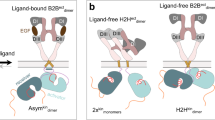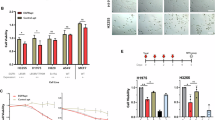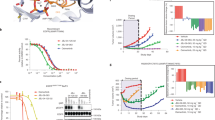Abstract
The abnormal activation of epidermal growth factor receptor (EGFR) is strongly associated with a variety of human cancers but the underlying molecular mechanism is not fully understood. By using direct stochastic optical reconstruction microscopy (dSTORM), we find that EGFR proteins form nanoclusters in the cell membrane of both normal lung epithelial cells and lung cancer cells, but the number and size of clusters significantly increase in lung cancer cells. The formation of EGFR clusters is mediated by the ionic interaction between the anionic lipid phosphatidylinositol-4,5-bisphosphate (PIP2) in the plasma membrane and the juxtamembrane (JM) region of EGFR. Disruption of EGFR clustering by PIP2 depletion or JM region mutation impairs EGFR activation and downstream signaling. Furthermore, JM region mutation in constitutively active EGFR mutant attenuates its capability of cell transformation. Collectively, our findings highlight the key roles of anionic phospholipids in EGFR signaling and function, and reveal a novel mechanism to explain the aberrant activation of EGFR in cancers.
Similar content being viewed by others
Log in or create a free account to read this content
Gain free access to this article, as well as selected content from this journal and more on nature.com
or
References
Hynes NE, Lane HA . ERBB receptors and cancer: the complexity of targeted inhibitors. Nat Rev Cancer 2005; 5:341–354.
Citri A, Yarden Y . EGF-ERBB signalling: towards the systems level. Nat Rev Mol Cell Biol 2006; 7:505–516.
Schlessinger J . Ligand-induced, receptor-mediated dimerization and activation of EGF receptor. Cell 2002; 110:669–672.
Jura N, Endres NF, Engel K, et al. Mechanism for activation of the EGF receptor catalytic domain by the juxtamembrane segment. Cell 2009; 137:1293–1307.
Endres NF, Das R, Smith AW, et al. Conformational coupling across the plasma membrane in activation of the EGF receptor. Cell 2013; 152:543–556.
Arkhipov A, Shan Y, Das R, et al. Architecture and membrane interactions of the EGF receptor. Cell 2013; 152:557–569.
Zhang X, Gureasko J, Shen K, Cole PA, Kuriyan J . An allosteric mechanism for activation of the kinase domain of epidermal growth factor receptor. Cell 2006; 125:1137–1149.
Hynes NE, MacDonald G . ErbB receptors and signaling pathways in cancer. Curr Opin Cell Biol 2009; 21:177–184.
Sharma SV, Bell DW, Settleman J, Haber DA . Epidermal growth factor receptor mutations in lung cancer. Nat Rev Cancer 2007; 7:169–181.
Fadeel B, Xue D . The ins and outs of phospholipid asymmetry in the plasma membrane: roles in health and disease. Crit Rev Biochem Mol Biol 2009; 44:264–277.
McLaughlin S, Murray D . Plasma membrane phosphoinositide organization by protein electrostatics. Nature 2005; 438:605–611.
Li L, Shi X, Guo X, Li H, Xu C . Ionic protein–lipid interaction at the plasma membrane: what can the charge do? Trends Biochem Sci 2014; 39:130–140.
Xu C, Gagnon E, Call ME, et al. Regulation of T cell receptor activation by dynamic membrane binding of the CD3epsilon cytoplasmic tyrosine-based motif. Cell 2008; 135:702–713.
Shi X, Bi Y, Yang W, et al. Ca2+ regulates T-cell receptor activation by modulating the charge property of lipids. Nature 2013; 493:111–115.
van den Bogaart G, Meyenberg K, Risselada HJ, et al. Membrane protein sequestering by ionic protein-lipid interactions. Nature 2011; 479:552–555.
Hansen SB, Tao X, MacKinnon R . Structural basis of PIP2 activation of the classical inward rectifier K+ channel Kir2.2. Nature 2011; 477:495–498.
Heo WD, Inoue T, Park WS, et al. PI(3,4,5)P3 and PI(4,5)P2 lipids target proteins with polybasic clusters to the plasma membrane. Science 2006; 314:1458–1461.
Abulrob A, Lu Z, Baumann E, et al. Nanoscale imaging of epidermal growth factor receptor clustering: effects of inhibitors. J Biol Chem 2010; 285:3145–3156.
Rust MJ, Bates M, Zhuang X . Sub-diffraction-limit imaging by stochastic optical reconstruction microscopy (STORM). Nat Methods 2006; 3:793–795.
Dani A, Huang B, Bergan J, Dulac C, Zhuang X . Superresolution imaging of chemical synapses in the brain. Neuron 2010; 68:843–856.
Heilemann M, van de Linde S, Schuttpelz M, et al. Subdiffraction-resolution fluorescence imaging with conventional fluorescent probes. Angew Chem Int Ed Engl 2008; 47:6172–6176.
Betzig E, Patterson GH, Sougrat R, et al. Imaging intracellular fluorescent proteins at nanometer resolution. Science 2006; 313:1642–1645.
Balzar M, Winter MJ, de Boer CJ, Litvinov SV . The biology of the 17–1A antigen (Ep-CAM). J Mol Med (Berl) 1999; 77:699–712.
Winter MJ, Nagtegaal ID, van Krieken JH, Litvinov SV . The epithelial cell adhesion molecule (Ep-CAM) as a morphoregulatory molecule is a tool in surgical pathology. Am J Pathol 2003; 163:2139–2148.
Messersmith WA, Ahnen DJ . Targeting EGFR in colorectal cancer. N Engl J Med 2008; 359:1834–1836.
Hurley JH, Meyer T . Subcellular targeting by membrane lipids. Curr Opin Cell Biol 2001; 13:146–152.
Zhang M, Chang H, Zhang Y, et al. Rational design of true monomeric and bright photoactivatable fluorescent proteins. Nat Methods 2012; 9:727–729.
Manders EMM, Verbeek FJ, Aten JA . Measurement of colocalization of objects in dual-color confocal images. J Microsc (Oxf) 1993; 169:375–382.
Varnai P, Thyagarajan B, Rohacs T, Balla T . Rapidly inducible changes in phosphatidylinositol 4,5-bisphosphate levels influence multiple regulatory functions of the lipid in intact living cells. J Cell Biol 2006; 175:377–382.
McLaughlin S, Smith SO, Hayman MJ, Murray D . An electrostatic engine model for autoinhibition and activation of the epidermal growth factor receptor (EGFR/ErbB) family. J Gen Physiol 2005; 126:41–53.
Sengupta P, Bosis E, Nachliel E, et al. EGFR juxtamembrane domain, membranes, and calmodulin: kinetics of their interaction. Biophys J 2009; 96:4887–4895.
Lowenstein EJ, Daly RJ, Batzer AG, et al. The SH2 and SH3 domain-containing protein GRB2 links receptor tyrosine kinases to ras signaling. Cell 1992; 70:431–442.
Skolnik EY, Lee CH, Batzer A, et al. The SH2/SH3 domain-containing protein GRB2 interacts with tyrosine-phosphorylated IRS1 and Shc: implications for insulin control of ras signalling. EMBO J 1993; 12:1929–1936.
Saito Y, Furukawa T, Arano Y, Fujibayashi Y, Saga T . Basic study on SH2 domain of Grb2 as a molecular probe for detection of RTK activation. Int J Oncol 2010; 37:281–287.
Jiang J, Greulich H, Janne PA, Sellers WR, Meyerson M, Griffin JD . Epidermal growth factor-independent transformation of Ba/F3 cells with cancer-derived epidermal growth factor receptor mutants induces gefitinib-sensitive cell cycle progression. Cancer Res 2005; 65:8968–8974.
Yuza Y, Glatt KA, Jiang J, et al. Allele-dependent variation in the relative cellular potency of distinct EGFR inhibitors. Cancer Biol Ther 2007; 6:661–667.
Lipson D, Capelletti M, Yelensky R, et al. Identification of new ALK and RET gene fusions from colorectal and lung cancer biopsies. Nat Med 2012; 18:382–384.
Vaishnavi A, Capelletti M, Le AT, et al. Oncogenic and drug-sensitive NTRK1 rearrangements in lung cancer. Nat Med 2013; 19:1469–1472.
van Rheenen J, Achame EM, Janssen H, Calafat J, Jalink K . PIP2 signaling in lipid domains: a critical re-evaluation. EMBO J 2005; 24:1664–1673.
Ellenbroek WG, Wang YH, Christian DA, Discher DE, Janmey PA, Liu AJ . Divalent cation-dependent formation of electrostatic PIP2 clusters in lipid monolayers. Biophys J 2011; 101:2178–2184.
Janmey PA, Lindberg U . Cytoskeletal regulation: rich in lipids. Nat Rev Mol Cell Biol 2004; 5:658–666.
Golub T, Caroni P . PI(4,5)P2-dependent microdomain assemblies capture microtubules to promote and control leading edge motility. J Cell Biol 2005; 169:151–165.
Low-Nam ST, Lidke KA, Cutler PJ, et al. ErbB1 dimerization is promoted by domain co-confinement and stabilized by ligand binding. Nat Struct Mol Biol 2011; 18:1244–1249.
Chung I, Akita R, Vandlen R, Toomre D, Schlessinger J, Mellman I . Spatial control of EGF receptor activation by reversible dimerization on living cells. Nature 2010; 464:783–787.
Sako Y, Minoguchi S, Yanagida T . Single-molecule imaging of EGFR signalling on the surface of living cells. Nat Cell Biol 2000; 2:168–172.
Kobayashi S, Boggon TJ, Dayaram T, et al. EGFR mutation and resistance of non-small-cell lung cancer to gefitinib. N Engl J Med 2005; 352:786–792.
Zheng C, Sun YH, Ye XL, Chen HQ, Ji HB . Establishment and characterization of primary lung cancer cell lines from Chinese population. Acta Pharmacol Sin 2011; 32:385–392.
Zhuang X . Nano-imaging with Storm. Nat Photonics 2009; 3:365–367.
Ji H, Li D, Chen L, et al. The impact of human EGFR kinase domain mutations on lung tumorigenesis and in vivo sensitivity to EGFR-targeted therapies. Cancer Cell 2006; 9:485–495.
Wu J, Gao J, Qi M, et al. High-efficiency localization of Na(+)-K(+) ATPases on the cytoplasmic side by direct stochastic optical reconstruction microscopy. Nanoscale 2013; 5:11582–11586.
Ripley BD . Tests of randomness for spatial point patterns. J R Stat Soc Ser B Stat Methodol 1979; 41:368–374.
Owen DM, Rentero C, Rossy J, et al. PALM imaging and cluster analysis of protein heterogeneity at the cell surface. J Biophotonics 2010; 3:446–454.
Aaron JS, Carson BD, Timlin JA . Characterization of differential Toll-like receptor responses below the optical diffraction limit. Small 2012; 8:3041–3049.
Acknowledgements
We thank Drs Pingyong Xu, Tao Xu, Xinyuan Liu and Liang Chen for material contribution and Drs Bo Huang, Zhaocai Zhou, Yan Feng, Tian Xiao and Yijun Gao for helpful discussion. We thank Yujuan Jin, Xiangkun Han, Yuetong Wang, Qibiao Wu, Fei Li, Shun Yao, Rong Liu, Haijiao Xu, Yibing Bai, Yan Jiang, Wei Yang, Jun Guo and Huizhen Wang for their technical support. This work was supported by MOST (2012CB910800 to HJ and CX, 2011CB933600 to HW, 2010CB912102 to HJ, and 2011CB910901 to CX), NSFC (31370747 and 81325015 to HJ, 21373200 to HW, 31070738 to CX, and 31330082 to JJ), CAS (the Strategic Priority Research Program XDB08020100 to CX, the 100 Talent Program to HW and CX, the “Cross and cooperation in science and technology innovation team” program to HJ, HW, CX and XD), and Science and Technology Commission of Shanghai Municipality (12JC1409800 to HJ). We also gratefully acknowledge the support of SA-SIBS scholarship.
Author information
Authors and Affiliations
Corresponding authors
Additional information
( Supplementary information is linked to the online version of the paper on the Cell Research website.)
Supplementary information
Supplementary information, Figure S1
EGFR form clusters in the plasma membrane of lung cancer cells and normal lung epithelial cells. (PDF 991 kb)
Supplementary information, Figure S2
PIP2 regulates the EGFR clustering in the plasma membrane. (PDF 218 kb)
Supplementary information, Figure S3
Rapamycin treatment of COS-7 cells does not affect the surface EGFR clustering. (PDF 248 kb)
Supplementary information, Figure S4
The JM region of EGFR is important for EGFR clustering in the plasma membrane. (PDF 232 kb)
Supplementary information, Figure S5
PIP2 is important for binding of downstream adaptor to EGFR during EGFR signaling transduction. (PDF 262 kb)
Supplementary information, Figure S6
No significant difference is observed between the dSTORM images of EGFR clusters from two different imaging time. (PDF 48 kb)
Supplementary information, Figure S7
Quantitative analysis of the localization precision of single Alexa647 conjugated Cetuximab or EGF in vitro and on living COS-7 cell surface. (PDF 164 kb)
Supplementary information, Figure S8
Ripley's K function analysis of EGFR membrane clusters. (PDF 117 kb)
Supplementary information, Table S1
The relative expression level of EGFR on the cell surface of different groups (PDF 34 kb)
Rights and permissions
About this article
Cite this article
Wang, Y., Gao, J., Guo, X. et al. Regulation of EGFR nanocluster formation by ionic protein-lipid interaction. Cell Res 24, 959–976 (2014). https://doi.org/10.1038/cr.2014.89
Received:
Revised:
Accepted:
Published:
Issue date:
DOI: https://doi.org/10.1038/cr.2014.89
Keywords
This article is cited by
-
Mutant APC reshapes Wnt signaling plasma membrane nanodomains by altering cholesterol levels via oncogenic β-catenin
Nature Communications (2023)
-
Electron transfer in protein modifications: from detection to imaging
Science China Chemistry (2023)
-
Mechanistic insights into HuR inhibitor MS-444 arresting embryonic development revealed by low-input RNA-seq and STORM
Cell Biology and Toxicology (2022)
-
Lattice complex assembled by noncompetitive anti-EGFR antibodies regulates actin cytoskeletal reorganization
Cancer Cell International (2020)
-
Cholesterol transport through the peroxisome-ER membrane contacts tethered by PI(4,5)P2 and extended synaptotagmins
Science China Life Sciences (2019)



